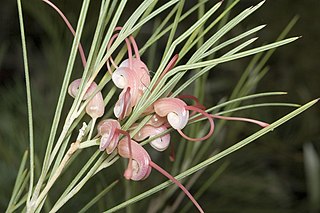
Grevillea erectiloba is a species of flowering plant in the family Proteaceae and is endemic to inland areas of south-west of Western Australia. It is dense, rounded shrub with divided leaves with up to fifteen linear lobes, and groups of bright red flowers that are green in the bud stage.

Grevillea annulifera, also known as prickly plume grevillea, is a species of flowering plant in the family Proteaceae and is endemic to northern Western Australia. It is a spreading to erect shrub with pinnatisect leaves with five to nine sharply-pointed, linear lobes, and cream-coloured to pale yellow flowers.
Grevillea angustiloba, commonly known as dissected holly-leaf grevillea, is a species of flowering plant in the family Proteaceae and is endemic to southern continental Australia. It is a prostrate, low-lying or erect shrub with deeply divided pinnate leaves and usually red, sometimes orange or pale yellow flowers.

Grevillea plurijuga is a species of flowering plant in the family Proteaceae and is endemic to southern Western Australia. It is a prostrate to low-lying or dense mounded to erect shrub with divided leaves with linear lobes and loose clusters of hairy, red or pink flowers.

Grevillea nana, commonly known as dwarf grevillea, is a species of flowering plant in the family Proteaceae and is endemic to the south-west of Western Australia. It is a prostrate to low, mounded, dense shrub with divided leaves with sharply-pointed, linear lobes, and clusters of pink, orange, yellow or red flowers.
Grevillea nematophylla, commonly known as water bush or silver-leaved water bush, is a species of flowering plant in the family Proteaceae and is endemic to Australia. It is shrub or small tree with simple or pinnatisect leaves, the leaves or lobes linear, and branched, cylindrical clusters of cream-coloured flowers.

Grevillea commutata is a species of flowering plant in the family Proteaceae and is endemic to the west of Western Australia. It is a spreading, open to dense shrub with egg-shaped leaves with the narrower end towards the base, and white, cream-coloured, and pinkish-green flowers.

Grevillea eriobotrya, commonly called the woolly cluster grevillea, is a species of flowering plant in the family Proteaceae and is endemic to a small area in the south-west of Western Australia. It is dense, erect, spreading shrub usually with linear leaves, and groups of white to creamy-white flowers.

Grevillea incrassata is a species of flowering plant in the family Proteaceae and is endemic to inland south-western Western Australia. It is an erect shrub with crowded cylindrical or narrowly linear leaves and clusters of bright yellow flowers.
Grevillea incurva is a species of flowering plant in the family Proteaceae and is endemic to inland south-western Western Australia. It is an erect shrub with linear adult leaves and clusters of creamy-yellow flowers.

Grevillea oligantha is a species of flowering plant in the family Proteaceae and is endemic to southern Western Australia. It is dense shrub with many erect branches, egg-shaped, lance-shaped or linear leaves, and groups of up to six brownish-yellow, orange or reddish-brown flowers with a pale yellow to reddish style.

Grevillea oncogyne is a species of flowering plant in the family Proteaceae and is endemic to inland areas of Western Australia. It is an erect to spreading shrub with linear, sometimes lobed leaves, and clusters of red or pinkish red flowers.

Grevillea paradoxa, commonly known as the bottlebrush grevillea, is a species of flowering plant in the family Proteaceae and is endemic to the south-west of Western Australia. It is an erect to spreading, prickly shrub with pinnatipartite leaves, the lobes linear, widely spreading and sharply pointed, and with cylindrical clusters of pale to dark pink or cream-coloured flowers with a pinkish-red style.

Grevillea patentiloba is a species of flowering plant in the family Proteaceae and is endemic to the south-west of Western Australia. It is a prostrate to erect, spreading to straggling shrub with divided leaves, and down-turned clusters of red to deep pink and cream-coloured to bright yellow flowers with a red to deep pink style.

Grevillea pityophylla is a species of flowering plant in the family Proteaceae and is endemic to inland areas of Western Australia. It is a dense shrub with linear to more or less cylindrical leaves and hairy, pinkish-red to bright red flowers.

Grevillea sparsiflora, commonly known as sparse flowered grevillea, is a species of flowering plant in the family Proteaceae and is endemic to the south of Western Australia. It is a low, spreading shrub with crowded, linear leaves and pinkish-red flowers arranged singly or in groups of up to five.
Grevillea stenostachya is a is a species of flowering plant in the family Proteaceae and is endemic to the west of Western Australia. It is a compact shrub with pinnatipartite to almost pinnatisect leaves with 3 to 5 lobes, the end lobes cylindrical and sharply pointed, and greenish-white to creamy yellow flowers with a cream-coloured to yellow style.

Isopogon crithmifolius is a species of plant in the family Proteaceae and is endemic to the south-west of Western Australia. It is a shrub with divided leaves and more or less spherical heads of glabrous reddish pink flowers.

Isopogon tridens, commonly known as the three-toothed coneflower, is a species of flowering plant in the family Proteaceae and is endemic to the southwest of Western Australia. It is a shrub with wedge-shaped leaves with two or three sharply-pointed teeth, and flattened-spherical heads of glabrous creamy white, sometimes purple flowers.

Grevillea singuliflora is a species of flowering plant in the family Proteaceae and is endemic to southeast Queensland. It is a sprawling or spreading shrub with oblong to egg-shaped or almost round leaves and green or cream-coloured flowers with a maroon style, arranged singly or in pairs on the ends of branches.

















